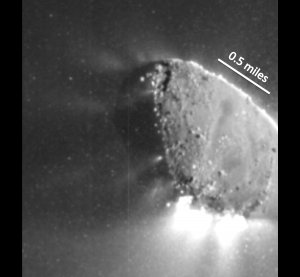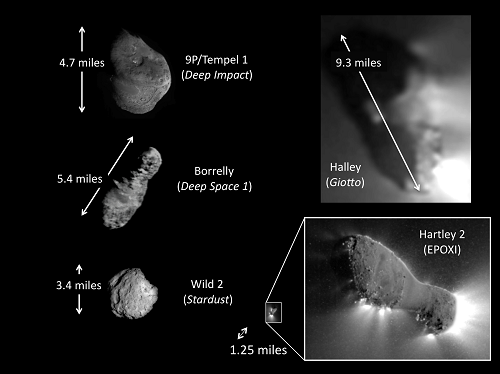
Keep an eye on the EPOXI site at the University of Maryland. New images from the Hartley 2 comet encounter are coming in, some of them truly breathtaking, as is the one at left. The jets clearly visible in the image can be linked with distinct areas on the surface of the comet, the first time we’ve ever seen a comet with this degree of clarity. Image by image, the tiny comet is yielding its secrets. We now learn that spectral analysis of the material coming from the cometary jets shows it to be primarily carbon dioxide, along with dust and ice particles.
Image: This enhanced image, one of the closest taken of comet Hartley 2 by NASA’s EPOXI mission, shows jets and where they originate from the surface. There are jets outgassing from the sunward side, the night side, and along the terminator — the line between the two sides. The image was taken by EPOXI’s Medium-Resolution Instrument on Nov. 4, 2010. The sun is to the right. Credit: NASA/JPL-Caltech/UMD.
Jessica Sunshine (University of Maryland), the mission’s deputy principal investigator, puts the findings in context:
“Previously it was thought that water vapor from water ice was the propulsive force behind jets of material coming off of the body, or nucleus, of comet. We now have unambiguous evidence that solar heating of subsurface frozen carbon dioxide (dry ice), directly to a gas, a process known as sublimation, is powering the many jets of material coming from the comet. This is a finding that only could have been made by traveling to a comet, because ground based telescopes can’t detect CO2 and current space telescopes aren’t tuned to look for this gas.”
With new data arriving at the rate of 2000 images a day, we should have much more to look forward to from Hartley 2, but the amount of carbon dioxide escaping the comet has proven to be the biggest surprise so far. It’s fascinating to realize that the dry ice producing the jets we see in the images has most likely been inside the comet since the earliest days of the Solar System. The EPOXI findings are consistent with what Deep Impact found at Tempel 1 back in 2005, though mission scientist Tony Farnham (University of Maryland) explains why the Tempel 1 results were less conclusive:
“Tempel 1 was most active before perihelion when its southern hemisphere, the hemisphere that appeared to be enhanced in CO2, was exposed to sunlight. Unlike our Hartley encounter, during the flyby with Tempel 1, we were unable to directly trace the CO2 to the surface, because the pole was in darkness during encounter.”
Taking Deep Impact to a second comet, then, has paid big dividends in the Hartley 2 data, which now point to carbon dioxide rather than water as the driver for cometary surface activity here and likely on other comets. We’re learning about comets step by step — EPOXI’s mission marks only the fifth time we’ve had close-up imagery of one — but we’re finding things no ground-based telescope could show us. The montage below puts all five cometary investigations into perspective.
Image: This montage shows the only five comets imaged up close with spacecraft. The comets vary in shape and size. Comet Hartley 2 is by far the smallest and has the most activity in relation to its surface area. This jet activity can be seen extending from the comet’s surface and into its outer shell of gas and dust, or coma. This is the first time scientists have been able to link jets to the details of the surface. Credit: NASA/JPL-Caltech/UMD.




Fascinating. It has been conventional wisdom I think for decades that comets are a major water reservoir. Cometary impacts have been used to explain movement of water and other volatiles to inner system worlds, and astronautics visionaries have assumed cometary water would be available as an exploitable resource.
Carbon dioxide as a driver for the surface activity is one thing, but does the spectral evidence actually contraindicate much water being present at all?
So much for the theory of where Earth’s oceans came from ?
Re water and carbon dioxide distribution, have a look at this figure, which I didn’t post this morning:
http://epoxi.umd.edu/3gallery/CarbonDioxide.shtml
Quoting from the caption:
Thank you! Data is always appreciated. So this really changes nothing aside from offering a clearer explanation of the outgassing mechanism, which is excellent in and of itself.
The presence of frozen carbon dioxide in comets seems very sensible/plausible to me. I wonder if they’ll find more compounds?
It always helps to have more hard facts.
This to me immediately raises questions about the nature of the jets on Halley’s comet, which was visited by several spacecraft back in 1986. Were those probes not looking for carbon dioxide either?
Hale-Bopp’s 37 miles is bigger than the black box :-) It’s a pity we didn’t get a close-up of that one.
This again reminds me that carbon is a fairly common element, and that the absence of carbon dioxide may be a much better atmospheric biomarker for exoplanets than the presence of oxygen.
Both Mars and Venus have plenty of CO2, only on Earth is it missing, a victim of fixation by carbon-based life forms, no doubt. There is much talk recently about the oxygenation of the atmosphere. It may be equally important to study its decarbonization.
May 17, 2011
Contact: Liz Zubritsky+1 301-614-5438 elizabeth.a.zubritsky@nasa.gov
Text & Images: http://www.nasa.gov/mission_pages/epoxi/hartley-2.html
AT THE HEART OF HARTLEY-2, A NEW BREED OF COMET?
At the heart of every comet lies a remnant of the dawn of the solar system. Or is that remnants? Astronomers don’t know, but the answer would give them a clearer picture of exactly how comets were born eons ago at the birth of the Solar System.
Did thin tendrils of dust and ice get drawn slowly inward and pack themselves into a single, uniform mass? Or did a hodge-podge of mini-comets come together to form the core for a comet of substance? For Hartley-2, the answer so far is neither.
“We haven’t seen a comet like this before,” says Michael Mumma of NASA’s Goddard Space Flight Center in Greenbelt, Md. “Hartley-2 could be the first of a new breed.”